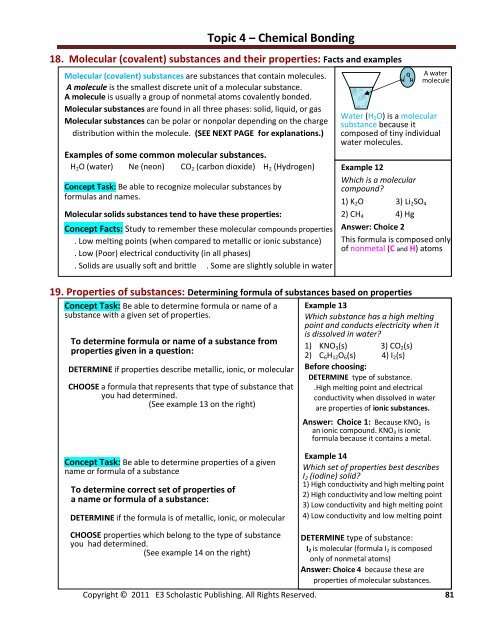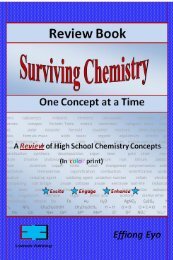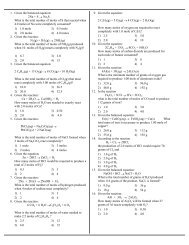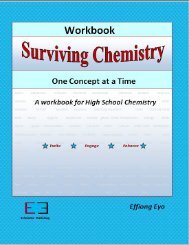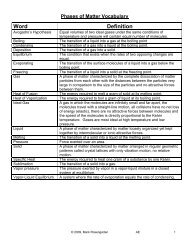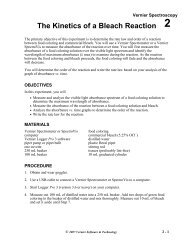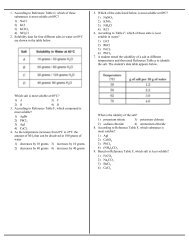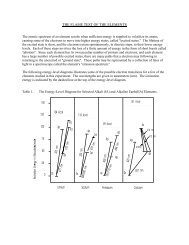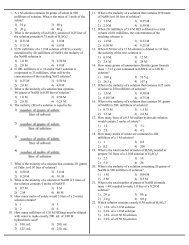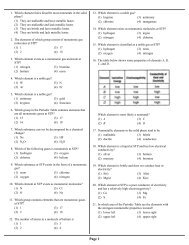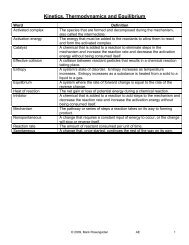Topic 1 - Matter and Energy - Revsworld
Topic 1 - Matter and Energy - Revsworld
Topic 1 - Matter and Energy - Revsworld
Create successful ePaper yourself
Turn your PDF publications into a flip-book with our unique Google optimized e-Paper software.
<strong>Topic</strong> 4 –.<br />
Chemical Bonding<br />
18. Molecular (covalent) substances <strong>and</strong> their properties: Facts <strong>and</strong> examples<br />
Molecular (covalent) substances are substances that contain molecules.<br />
A molecule is the smallest discrete unit of a molecular substance.<br />
A molecule is usually a group of nonmetal atoms covalently bonded.<br />
Molecular substances are found in all three phases: solid, liquid, or gas<br />
Molecular substances can be polar or nonpolar depending on the charge<br />
distribution within the molecule. (SEE NEXT PAGE for explanations.)<br />
q Examples e of some common molecular substances.<br />
H 2 O (water) Ne (neon) CO 2 (carbon dioxide) H 2 (Hydrogen)<br />
Concept Task: Be able to recognize molecular substances by<br />
formulas <strong>and</strong> names.<br />
Molecular solids substances tend to have these properties:<br />
Concept Facts: Study to remember these molecular compounds properties<br />
. Low melting points (when compared to metallic or ionic substance)<br />
. Low (Poor) electrical conductivity (in all phases)<br />
. Solids are usually soft <strong>and</strong> brittle . Some are slightly soluble in water<br />
O / \<br />
H H<br />
A water<br />
molecule<br />
Water (H 2 O) is a molecular<br />
substance because it<br />
composed of tiny individual<br />
water molecules.<br />
Example 12<br />
Which is a molecular<br />
compound?<br />
1) K 2 O 3) Li 2 SO 4<br />
2) CH 4 4) Hg<br />
Answer: Choice 2<br />
This formula is composed only<br />
of nonmetal (C <strong>and</strong> H) atoms<br />
19. Properties of substances: Determining formula of substances based on properties<br />
Concept Task: Be able to determine formula or name of a<br />
substance with a given set of properties.<br />
To determine formula or name of a substance from<br />
properties given in a question:<br />
DETERMINE if properties describe metallic, ionic, or molecular<br />
CHOOSE a formula that represents that type of substance that<br />
you had determined.<br />
(See example 13 on the right)<br />
Example 13<br />
Which substance has a high melting<br />
point <strong>and</strong> conducts electricity when it<br />
is dissolved in water?<br />
1) KNO 3 (s) 3) CO 2 (s)<br />
2) C 6 H 12 O 6 (s) 4) I 2 (s)<br />
Before choosing:<br />
DETERMINE type of substance.<br />
.High melting point <strong>and</strong> electrical<br />
conductivity when dissolved in water<br />
are properties of ionic substances.<br />
Answer: Choice 1: Because KNO 3 is<br />
an ionic compound. KNO 3 is ionic<br />
formula because it contains a metal.<br />
Concept Task: Be able to determine properties of a given<br />
name or formula of a substance<br />
To determine correct set of properties of<br />
a name or formula of a substance:<br />
DETERMINE if the formula is of metallic, ionic, or molecular<br />
Example 14<br />
Which set of properties best describes<br />
I 2 (iodine) solid?<br />
1) High conductivity <strong>and</strong> high melting point<br />
2) High conductivity <strong>and</strong> low melting point<br />
3) Low conductivity <strong>and</strong> high melting point<br />
4) Low conductivity <strong>and</strong> low melting point<br />
CHOOSE properties which belong to the type of substance<br />
you had determined.<br />
(See example 14 on the right)<br />
DETERMINE type of substance:<br />
I 2 is molecular (formula I 2 is composed<br />
only of nonmetal atoms)<br />
Answer: Choice 4 because these are<br />
properties of molecular substances.<br />
Copyright © 2011 E3 Scholastic Publishing. All Rights Reserved. 81


